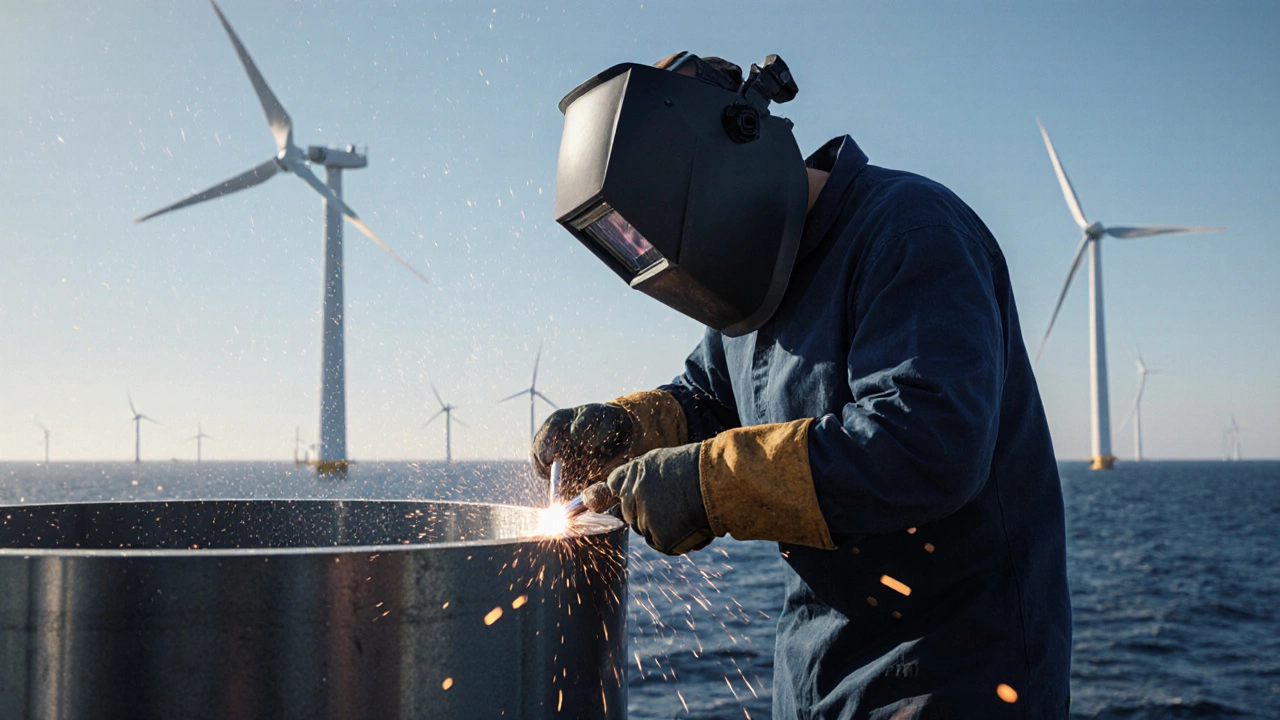Welding Career Salary Estimator
Your Welding Profile
Why This Matters
Based on 2024 industry data, skilled welders in high-demand specializations earn significantly more than entry-level positions. Industry reports show over 18,000 welders needed in the UK by 2027, with pay increasing for specialized skills.
Estimated Annual Salary
Salary ranges based on UK market data from Construction Industry Training Board (CITB) and industry reports. Includes potential offshore premiums for specialized roles.
Welding isn’t just a job anymore-it’s a lifeline for industries that keep the world running. If you’ve heard that automation killed off welding jobs, you’re hearing the wrong story. Factories still need people to weld pipelines, ships, bridges, and wind turbines. Hospitals need welders to fix medical equipment. Even electric car makers are hiring welders to build battery frames and chassis. The demand isn’t disappearing-it’s changing. And if you know where to look, there are more opportunities now than there were five years ago.
Welding isn’t dying-it’s evolving
Let’s clear up the biggest myth: robots didn’t replace welders. They replaced bad welders. Machines can follow a programmed path, but they can’t adapt when a metal joint is rusty, warped, or misaligned. That’s where human welders come in. Skilled welders inspect, adjust, and fix what machines can’t handle. In 2024, the U.S. Bureau of Labor Statistics reported over 350,000 welding jobs still open nationwide. In the UK, the Construction Industry Training Board (CITB) estimates a shortage of 18,000 skilled welders by 2027. That’s not a gap-it’s a doorway.
Welding isn’t just about steel beams anymore. It’s in aerospace, where welders join titanium alloys for jet engines. It’s in offshore wind farms, where technicians weld underwater structures that last 30 years. Even food processing plants need welders to build sanitary, leak-proof tanks. These aren’t dusty factory jobs. They’re high-tech, high-paying roles that require precision, problem-solving, and real skill.
Where the jobs are-and how much they pay
If you’re wondering where to find welding work, look beyond the traditional construction sites. The biggest growth is in energy and infrastructure. Offshore wind projects in the North Sea alone are hiring hundreds of welders each year. The UK government’s Net Zero Strategy has committed £160 billion to clean energy by 2030. A lot of that money is going into welding-heavy projects like hydrogen pipelines and nuclear plant upgrades.
Here’s what you can actually earn:
- Entry-level welder: £22,000-£28,000 per year
- Certified pipe welder (ASME IX): £35,000-£45,000
- Underwater welder: £50,000-£80,000 (with offshore premiums)
- Robotic welding technician: £38,000-£55,000
Welders with certifications in TIG, MIG, and stick welding, especially those trained for pressure systems or aerospace standards, are in the highest demand. A single certification in ASME Section IX can double your earning potential. And unlike college degrees, these certifications take months, not years.
Welding courses: What actually matters
Not all welding courses are created equal. If you’re thinking about training, skip the 12-week “learn to weld” programs that don’t prepare you for real jobs. Employers don’t care if you can hold a torch. They care if you can pass a certified weld test under pressure.
The gold standard is NVQ Level 2 or 3 in Welding Operations, which is recognized across the UK and Europe. These courses include:
- Practical welding on carbon steel, stainless steel, and aluminum
- Reading blueprints and welding symbols
- Quality control and inspection techniques
- Health and safety compliance (especially for confined spaces and high-risk environments)
Look for colleges or training centers that partner with employers. Many offer apprenticeships where you earn while you learn. In Bristol, for example, City of Bristol College runs a welding program with direct links to aerospace suppliers and offshore contractors. Graduates often get job offers before they even finish.
Don’t just take any course-ask: Can I get certified to ASME, EN 1090, or AWS standards? If the answer is no, keep looking.
Who hires welders now?
Welding isn’t just for construction companies anymore. Here’s who’s actively hiring:
- Offshore energy firms (BP, Shell, Equinor): Need welders for platforms, subsea pipelines, and decommissioning projects.
- Aerospace manufacturers (BAE Systems, Rolls-Royce): Require precision TIG welders for engine parts and airframes.
- Rail and transport (Network Rail, Hitachi): Hiring for new train carriages and bridge repairs.
- Medical equipment suppliers: Welders who can create sterile, seamless joints for MRI machines and dialysis units.
- Renewable energy installers: Wind turbine manufacturers need welders for tower sections and nacelles.
Even the NHS has started hiring welders to repair and maintain high-value diagnostic equipment. It’s not just about metal anymore-it’s about keeping critical systems running.
What skills do you need beyond the torch?
Today’s welders aren’t just hands-on-they’re tech-savvy. Many jobs now require:
- Basic computer skills to read digital blueprints
- Understanding of welding robots and automated systems
- Ability to use laser measuring tools and ultrasonic testers
- Knowledge of safety protocols for hazardous environments
Employers aren’t just hiring welders. They’re hiring problem-solvers who can read a flaw in a weld, figure out why it happened, and fix it before it becomes a failure. That’s why certifications like the City & Guilds Level 3 in Advanced Welding include modules on inspection and defect analysis.
Even if you start with basic MIG welding, getting trained in inspection and quality control can open doors to supervisory roles. Many senior welders today started as apprentices and moved up by learning how to check their own work-and others’.
Is it worth it? Real stories from the field
Take Mark, 29, from Cardiff. He dropped out of college after two semesters. He signed up for a 16-week welding course at a local college. Six months later, he was working on a wind farm project off the coast of Wales. He earns £42,000 a year, works four days on, four days off, and gets free accommodation on-site.
Or Lisa, 34, a former retail manager in Manchester. She took a part-time NVQ Level 2 while raising her kids. Two years later, she’s welding medical equipment for a company that supplies NHS hospitals. She says, “I never thought I’d be doing something this important-and getting paid well for it.”
These aren’t outliers. They’re typical. The average age of a welder in the UK is 52. That means thousands are retiring in the next decade. The industry isn’t just hiring new people-it’s scrambling to replace them.

What’s next? How to get started
If you’re serious about welding, here’s your roadmap:
- Find an accredited training provider with NVQ or City & Guilds certification.
- Start with NVQ Level 2 in Welding Operations-it’s the baseline employers expect.
- Choose your focus: pipe welding, structural steel, or TIG for thin metals.
- Get certified in at least one industry standard (ASME, AWS, EN 1090).
- Apply for apprenticeships or trainee roles-many employers pay you while you learn.
- Keep learning: take advanced courses in robotic welding or underwater welding after you’ve got experience.
There’s no need to go into debt. Many training programs are funded through government schemes like the Skills Bootcamps in the West of England. Some even cover tools and safety gear.
Frequently Asked Questions
Is welding a dying trade in 2025?
No. Welding is not dying-it’s transforming. While some basic welding jobs have been automated, skilled welders are in higher demand than ever. Industries like renewable energy, aerospace, and medical manufacturing need welders who can handle complex materials and meet strict quality standards. The UK alone faces a shortage of over 18,000 qualified welders by 2027.
How long does it take to become a certified welder?
You can become a certified welder in as little as 3 to 6 months with the right training. NVQ Level 2 courses typically take 12 to 16 weeks full-time. After that, you’ll need to pass a practical certification test, which many training centers help you prepare for. Advanced certifications like ASME IX or underwater welding can take another 6 to 12 months, depending on your experience and specialization.
Can women succeed in welding?
Absolutely. While welding has been male-dominated, the industry is actively encouraging more women to join. Many training programs now offer women-only cohorts with mentorship support. Women welders are working in aerospace, offshore energy, and medical equipment-fields that value precision over strength. Organizations like Women in Welding UK are helping break down barriers and connect women with employers.
Do I need a degree to become a welder?
No. A college degree is not required. Employers prioritize certifications, hands-on skills, and proven ability over academic credentials. NVQs, City & Guilds, and industry-specific certifications (like AWS or ASME) are what matter. Many welders start with short-term training programs and build their careers through apprenticeships and on-the-job experience.
What’s the job security like for welders?
Welding offers strong job security, especially for certified professionals. Unlike many tech jobs that can be outsourced, welding requires someone physically present to handle materials, tools, and inspections. With infrastructure aging and clean energy projects expanding, demand is expected to grow for at least the next 15 years. Skilled welders rarely face unemployment-if they’re qualified, they’re hired.
Final thought: Your hands can build the future
Welding isn’t about getting your hands dirty-it’s about building things that last. Bridges. Power plants. Life-saving equipment. The machines that make clean energy possible. The people who do this work aren’t just laborers. They’re engineers of structure, safety, and innovation. And right now, the world needs more of them.
If you’ve ever thought about learning a trade that pays well, offers stability, and lets you see the results of your work-welding isn’t just an option. It’s one of the best choices you can make in 2025.





Write a comment